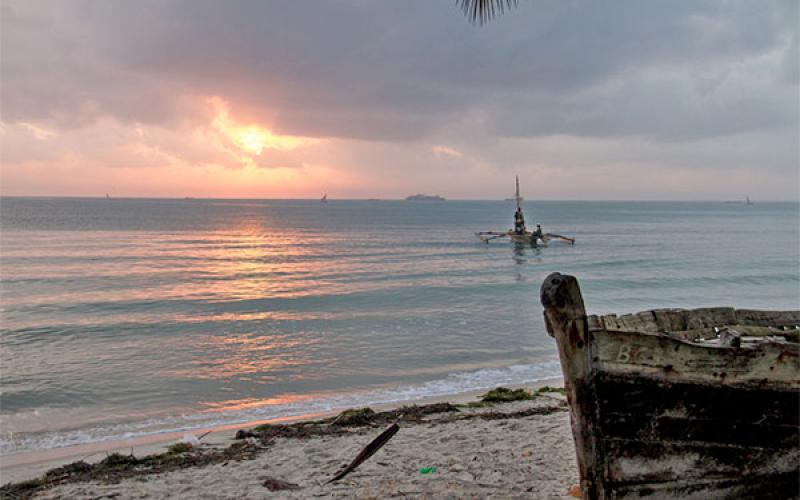
At the end of April, the international community will meet in the Hague for the Global Oceans Action Summit for Food Security and Blue Growth. The summit will bring together representatives from governments, international agencies, NGOs and the private sector. This is the second in a series of blog posts in the run up to the Summit.
Recommended publications
- Rice fields to prawn farms: a blue revolution in southwest Bangladesh?
- Mariculture development and livelihood diversification in the Philippines
At the end of April, the international community will meet in the Hague for the Global Oceans Action Summit for Food Security and Blue Growth. The summit will bring together representatives from governments, international agencies, NGOs and the private sector. This is the second in a series of blog posts in the run up to the Summit.
The term ‘blue growth’ describes national and international strategies through which investments in oceans can achieve sustainable development. As with any strategy, defining metrics for tracking success is essential. The CGIAR, the global agriculture research partnership for a food secure future of which we are a part, is currently deciding on the metrics it will use to track progress against the intermediate development outcomes it intends to achieve through it’s research programs. Using the four indicator categories in the emerging framework for measuring green growth, here is how we might include measures of blue growth success for our work at WorldFish.
Natural Asset Base
Monitoring indicators for our natural asset base help us minimize risks and avoid unsustainable practices. The most obvious blue growth metric for WorldFish under this category concerns the sustainability of fisheries. Ensuring we harvest fisheries at levels that limit the risks of stock collapse is a fundamental pre-requisite. The number of communities we have helped to establish effective fisheries management or the average annual catch per unit of fishing effort over an appropriate period would be good measures of our success.
WorldFish also focuses on conserving coastal ecosystems. These habitats are vital for the livelihoods and food security of millions of poor people. Not only do they provide nursery areas for many coastal fish populations, they also provide fuel, building materials and coastal protection. The areas of habitat under effective protection or restored, are good indicators of success.
Environmental and Resource Productivity
Indicators in this category tell us whether we are benefitting from ocean productivity in ways that minimize our demands on the environment. For WorldFish, the key focal area is mariculture. In the Blue Frontiers Report, we explore the environmental impact of aquaculture and provide an overview of aquaculture’s environmental demands. Looking ahead, the challenge is to support governments and producers to improve policies and practices so that the environmental footprint grows at a very much lower rate than the growth in production. Measuring feed, energy, water use and waste production per unit of food produced at both farm and national levels will be essential for tracking progress.
Although, fresh water aquaculture remains the dominant source of farmed fish (about 70 percent) and is likely to remain so for future production growth, the potential for mariculture to grow in many developing countries remains significant. Both seaweed and shellfish culture offer particular promise, given their limited environmental demands, although increasing ocean acidification threatens the growth of shellfish farming.
Environmental Quality of Life
Ensuring the environmental quality of coastal systems is key to people’s health and well-being. There are signs that we are getting this wrong: recurring and more frequent toxic algal blooms, near shore coral reef degradation and increasing coastal pollution are important indicators. Improving water quality measures can pave the way for increased ecotourism and recreational use of the sea by coastal communities.
Although helping improve water quality is not a core activity for WorldFish, we recognize that growth in fisheries and aquaculture exists in a broader economic context. For example, when ecotourism in a rural economy grows alternatives to making a livelihood through fishing emerge, making fisheries reform easier. So, our measure of success in this area is to help build partnerships with others to help ensure that development strategies for coastal communities are integrated and fisheries and aquaculture are considered within a broader rural development context.
Political and Economic Opportunities
This category of indicators focused on policies and economic opportunities related to greenhouse gases. Fuel subsidies for fishing fleets are perhaps the most relevant issue from a WorldFish perspective. As a report by the Global Oceans Commission documents, there is ample evidence that fuel and other subsidies have helped drive over-fishing in the large-scale fisheries. The number and amount of subsidies currently in place is an obvious indicator to track, something that is currently being done by EU Fisheries.
For small-scale fisheries, however, the case is less clear. In a recent report on this topic, Tony Charles argues that fishery subsidies might be best evaluated, not only for their trade distorting and environmental impacts, but also for the extent to which they contribute to or impede progress toward development including food security and poverty alleviation.
Blue growth is important for the oceans community. I look forward to hearing the perspectives of others and how they plan to measure their progress and ensure success.
Download Global Oceans Action Summit for Food Security and Blue Growth. Below